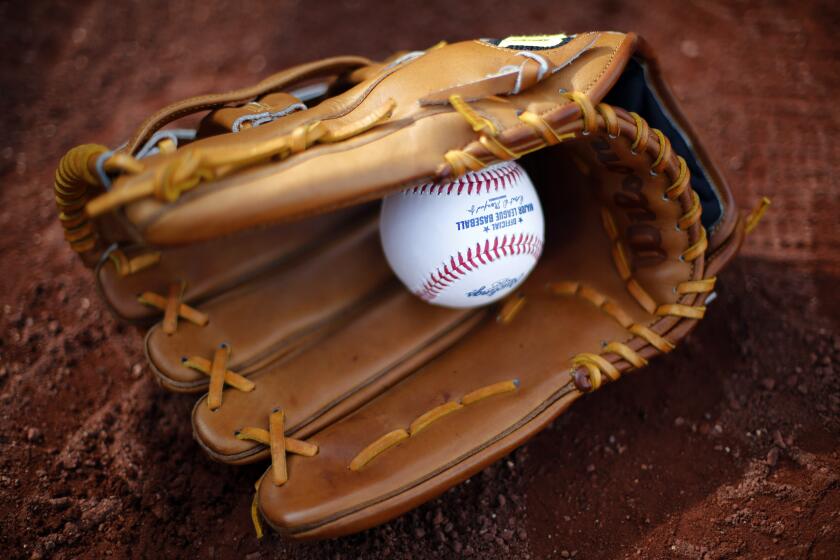Abbott Moves Up, Gets Better
- Share via
Face it. A kid born with one hand is never going to pitch in the big leagues. It was a nice fantasy. Everybody loved Jim Abbott when he won the ’87 Sullivan Trophy as America’s top amateur athlete. But, now he’s pitching to grown men.
Obviously, international competition bothers Abbott a lot. Take him out of the small pond of college baseball--where he was 26-8 at Michigan (3.03 career earned-run average) and, last month, became a No. 1 draft choice of the Angels--and the truth starts to come out. Facing Cuba, Japan and Taiwan--average age about 28--we’ve seen a much different Abbott for two summers.
Last year, he had an ERA of 0.00 in three appearances in the Pan American Games. He also became the first U.S. pitcher to beat Cuba in Havana in 25 years.
This summer, the U.S. national team--collegians headed to the Olympics--are barnstorming. And, as usual, Abbott is getting his ears pinned back. His ERA is 0.00 again. He has given up four hits already--in three games.
Just when you think Abbott has surpassed all rational expectations, he moves up a level--and gets better.
Olympic Coach Mark Marquess, whose Stanford team has won back-to-back NCAA titles, said, “As a person, they told me Abbott was the All-American boy--almost too good to be true. But he’s surprised me. He’s better than that, if a person can be. . . . As a pitcher, he didn’t have a great junior year (this season). I expected him to be a polished left-hander. What I didn’t know is that, right now, he’s the hardest thrower on my staff. The Japanese (hitters) aren’t going to be divin’ in on him. He brings it too hard.”
Once upon a time, being America’s best Olympic pitcher meant little. Now, after the ’84 Olympic team sent Will Clark, Mark McGwire, Cory Snyder, Barry Larkin, B.J. Surhoff, Mike Dunne and others to the majors in a hurry, the Olympic team is a Grade A pedigree. This year, Abbott and second baseman Ty Griffin of Georgia Tech (batting .564 and slugging 1.161) have been the show stoppers so far for a nice 13-3 squad.
To understand Abbott, it helps to watch him on a 102-degree day recently in a small Maryland town in the foothills of the Shenandoah Mountains when he’s not scheduled to pitch. The grandstand is standing room only--that’s 6,500 in Hagerstown--and the public-address system plays “Some Kinda Wonderful.” Abbott heads to the bullpen to do some work. Some think he’s almost the finished product. He thinks he’s only halfway there.
“I think you develop to your (level of) competition. You learn to do what they force you to learn,” Abbott said. “When I went to Michigan, I just had a fastball. Then a curve. I added a cut fastball, which is my slider. Now, I’m working on a straight changeup and slow curve. And I know I have to learn to pitch inside. That’s the big thing.”
In college, with aluminum bats, low and away is the key location. In pro ball, with wooden bats and a generation of Jose Cansecos who feed off any pitch that lets them extend their huge arms, the inside corner, especially for a left-handed pitcher, is the heart and soul of success.
“It’s totally different,” Abbott said. “You gotta hit some people. In Japan (on a five-game tour this month), I hit a guy flat in the face. I’d never done that before. But I have to get over it. It’s part of the game.”
In the bullpen, the dust hangs heavy in the air, the catchers don’t want to crouch and even the billboards seem to shimmer with a wavering desert-heat quality. Abbott works through his entire repertoire, throwing almost machine-gun fast. Fastballs and sliders--in, down and in, and then far enough inside that you can see imaginary hitters skipping rope, sucking in their guts, diving under the low bridge. Jim Abbott has had to overcome a lot; if hitters have to overcome some heat in their kitchens, the 6-foot 3-inch, 200-pound kid with the choirboy face might not mind as much as you’d think.
Abbott’s glove stays on his stump of a right hand, just six inches from where his left hand ends his balanced follow-through. If a batter were at the plate, he would pluck it off and put it on his left hand in one motion after every pitch; Abbott has done it so quickly and smoothly for so long that some fans barely notice his handicap.
“He’s an average fielder. I expected below average,” Marquess said. “They bunt on him. He throws them out. Next case.”
It’s the line drives through the box that scouts worry about. “That question grinds at you,” Abbott said. “I’ll try to do the best I can. I can talk till I’m blue. That doesn’t prove anything. But I think I can (protect myself).”
Is it possible that the worst danger is actually almost behind him--the lethal aluminum bats that create liners faster than any in the major leagues? “That’s possible,” he said, grinning.
Finally, pouring sweat, Abbott switches to straight changeups. They’re raw. Some bounce. But they’re all low, and his motion is almost the same. Already, it could be a waste pitch.
These days, Abbott is a 20-year-old in a sweatbox laboratory. The U.S. national team plays a schedule that would exhaust any minor league team. Six-hour bus rides, a 12-hour flight to and from Japan, seldom two nights in one town and never three. The minors can’t be this hard, not with 4:15 a.m. wake-up calls and big-time media in every town. After a 6 a.m. flight, they got to Durham, N.C., at 9 a.m. only to find that their hotel rooms would not be vacated for several hours.
“Is this how the U.S. Olympic basketball team travels?” Abbott asked.
Even when they got to the Durham Bulls’ park--yes, where the movie was made--they found out that, as Abbott said, “The bull is really in foul territory.” Another Hollywood trick.
Abbott and his teammates are meeting real baseball this summer, not college ball with training tables and more days off than games. The question isn’t “Can you play?”, it’s “Can you play every day?” Play exhausted. Play depressed. Manage your body, your mind, your time. Some are chewed up. Some eat it up.
So far, and it’s early, Abbott seems to like the learning process. He’s fascinated to face an entire Japanese team--the defending Olympic champions who beat the United States in the finals in Dodger Stadium in ‘84--full of high fastball guess hitters. He and Andy Benes, the No. 1 pick in the whole draft, marvel at a team so disciplined that players will “start swinging while you’re in your windup so they can get out in front of your best fastball,” even though they may look ridiculous--fooled by 10 feet--on a changeup.
This summer will seem interminable, and sometimes demoralizing. Sure, the nationals went 2-3 in Japan and have crushed Taiwan, 6-0, back in the United States. But those seven consecutive games in August with Cuba, then the World Championships in Italy (with Cuba on hand again) in early September, will be man-sized work.
“Cuba is better than some major league teams. No question,” Marquess said.
By late September, when the United States plays the first of five games that could win it an Olympic exhibition-sport title, this team--and Abbott--will either be worn to a frazzle or part of the way to grown up.
Many questions will be asked about this Olympic team. But no one will face as many as Abbott, who has fascinated baseball fans with his unique personality and his unique liability. For now, why not look at it this way: Some athletes seem followed by a special destiny that seeks them even as they pursue it. For example, Abbott has the inside track on the first-game Olympic starting assignment. Circle the date: Sept. 19. Abbott has until then to finish becoming a man at his game.
Sept. 19 also is Abbott’s 21st birthday.
More to Read
Go beyond the scoreboard
Get the latest on L.A.'s teams in the daily Sports Report newsletter.
You may occasionally receive promotional content from the Los Angeles Times.










